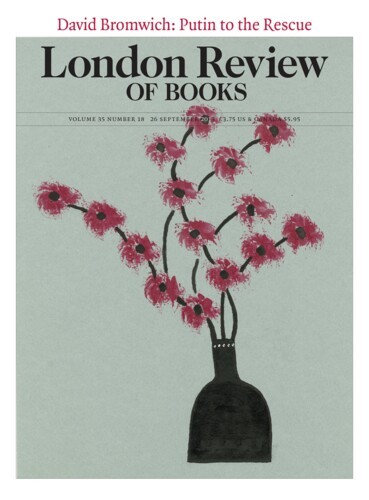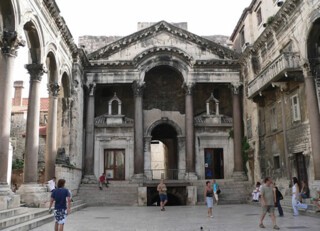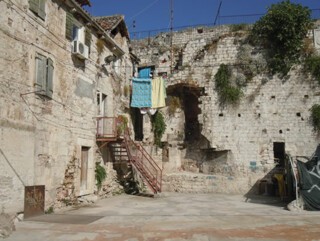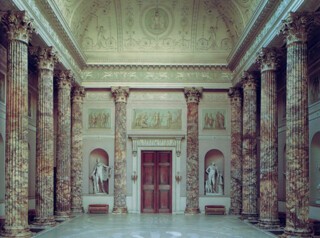The train journey from Zagreb to Split takes six hours and entails a degree of mental adjustment. Zagreb is quiet in summer. A city of government and business, it mostly closes for August, leaving the streets to tourists, who come in modest numbers. Stucco-fronted apartment blocks in ice-cream colours, the dripping Jugendstil of the Croatian Secessionists, tree-lined squares; on the verge of autumn the city has a lingering air of Austria-Hungary. At the other end of the mountainous dog-leg railway that joins historic Croatia to Dalmatia, Split is the modern state’s second city, a Unesco World Heritage site and the relic of a different empire.
From the station it is a crowded ten-minute walk to the seafront entrance of Diocletian’s Palace, which leads into the basement halls. The smack of sulphur, hot air and cold stone is sharp on the nose. Underfoot is damp. The vaults echo with canned folk music, tourists, some wearing togas and plastic laurel wreaths, and stalls loaded with coral, turquoise, ‘I ♥ Croatia’ baseball hats and very bad prints of Rod Stewart. The visitor whose expectations have been formed by Robert Adam’s Ruins of the Palace of the Emperor Diocletian at Spalatro of 1764, may feel momentarily taken aback, but in essence nothing has changed for the palace is not in the city, the city is in the palace and it has been there, growing and adapting, for more than a thousand years.
Diocletian died in 316 AD, after which there was a lull of several centuries when the site seems to have been abandoned until an influx of refugees from Salona, fleeing the Slavs, took over the ruins. They have been inhabited ever since. What Adam found in 1757 was already a palimpsest. Centuries of infiltration had first entwined the town around the palace and then broken out beyond it. Diocletian’s body had been removed by the Christians he so fiercely persecuted, and his mausoleum turned into a Catholic cathedral acquiring in succession a spectacular Gothic pulpit, an early Renaissance side altar and a Baroque sanctuary. The Temple of Jupiter became its baptistery and on its coffered ceiling rows of Roman masks, tragical and comical, smile and gasp alternately down at the font.
By Adam’s day the town of Spalatro belonged to the Venetians, who took a dim view of a party of foreigners apparently sketching their fortifications. Suspected of espionage, Adam and his team were seen off after five uneasy weeks of rapid work. The Venetians’ massive defensive walls survive, though they have long since been breached, not from outside but by the ever expanding city within. Today ‘inhabited’ scarcely begins to describe the palace: it is stuffed, not only with tourists, but with shops, houses, hotels, clubs and a bank. Between the massive braces stabilising the fabric, apartments hang like nesting boxes amid plant pots and washing. Every ancient ledge doubles as a café table or bench. Croatian folk singers exploit the acoustics in the vestibulum and in the central open space, the peristyle, children sit astride a sphinx to watch mock gladiator fights. When the novelty of feeling like an extra in Carry on Cleo wears off, however, it is possible to see what Adam saw, as well as much that has been uncovered since, and to grasp the complicated interleaving of Egypt, Rome and 18th-century Scotland.
One of the few architects to have a style named after him, it was Split that made Adam’s name. He went at the end of his Grand Tour to document this obscure late provincial Roman monument. It was an idiosyncratic choice for the time, but shrewd. A private, domestic building, unlike the baths and temples that provided most source material for neoclassical architects, it was also within reach. Adam was not, yet, quite a gentleman. He couldn’t afford to follow the Dilettanti into Greece, so instead, with a large team of draughtsmen and engravers whose contributions he subsequently did his best to obscure, he compiled a volume intended to impress classicists and potential clients. Its publication succeeded in speeding his translation from Scotland to London and creating a reputation for the epitome of elegant neoclassicism, practised in the squares of Edinburgh and country houses on both sides of the border.
But architects are unreliable narrators. Adam’s was a paper palace as much his own as Diocletian’s. He omitted post-Roman interventions, improved, completed or simply changed what he saw to make ‘elegantly historiz’d … adjacencies’. His audience expected no less. Taste required that the romance of antiquity be captured in picturesque views, where peasants sitting on broken columns conveyed the poignancy of decline and fall. Yet at the same time his book included serious archaeology. Plans and measured sections accompanied the views. It was the first attempt to document systematically a building whose history and function are still a matter of debate. Two centuries of research began with Adam’s Herculean attempt to boost his career.
From the very beginning the palace was a synthesis, bearing the marks of earlier history. Building probably started in 298 AD on a perfect site, backed by mountains and fronted by the sea. It was to be a fort, temple complex, villa and mausoleum; gracious yet muscular, it spoke of power. The emperor built into it relics from his triumphant campaign in Egypt. Columns made of porphyry and rose granite from Egyptian temples support Roman capitals in the peristyle. Eleven basalt sphinxes once brooded over the ceremonial areas. A great arch, breaking into a pediment, reflects Diocletian’s familiarity with the architecture of Ephesus and Palmyra. He abdicated in 305 AD in failing health but it isn’t certain whether Split was always intended to be a spectacular retirement home or conceived as an imperial palace, its ritual spaces there to serve the cult of the emperor as god.
It was these spaces and their potential which Adam took back to Britain along with his notes and drawings. He coined the Spalatro Order, an adaptation of an unusual capital in the peristyle; and more dramatically, he exploited the connecting volumes, the circle of the vestibulum and its relation to the rectangle of the peristyle, to ‘seize the beautiful spirit of antiquity’ and transport it. At Kedleston in Derbyshire, his house for Lord Scarsdale, they inspired a masterpiece, the marble hall and the saloon, one of the grandest sequences of rooms in Britain.
Since Adam’s day much more has come to light at Split. The cellars have been cleared and while they are not practically useful for much more than their present function as a tourist trap, their layout reflects the plan, later obliterated, of the ground floor above them, opening up a new chapter in the understanding of Diocletian’s building. Renovations in the popular Luxor café uncovered the floor of the Temple of Venus and remains of a Romanesque loggia. Diocletian’s Palace continues in a state of transformation.
Send Letters To:
The Editor
London Review of Books,
28 Little Russell Street
London, WC1A 2HN
letters@lrb.co.uk
Please include name, address, and a telephone number.




